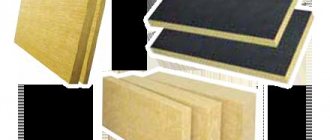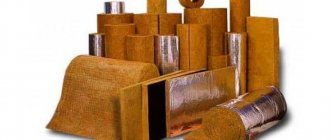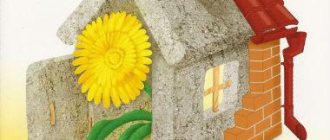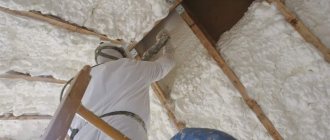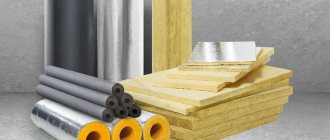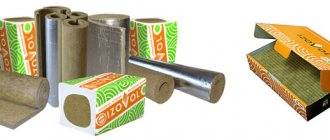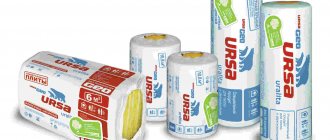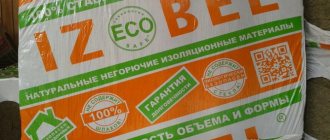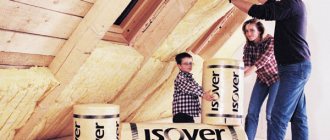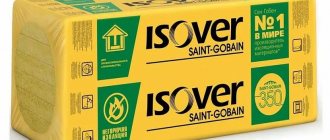Last time we talked about roll insulation. Today, in continuation of this topic, we will take a detailed look at Rockwool insulation: dimensions, characteristics, scope of application. The entire Rockwool line of mineral wool is made from a volcanic rock called basalt. Therefore, such thermal insulation is also called basalt or stone wool. Production was established in Denmark and Sweden in 1937. Since that time, the company has expanded significantly and opened its branches in Europe, Asia, and North America. Today it is the most famous brand among mineral wool insulation, the high quality of which is beyond doubt.
Rockwool - stone wool insulation
Rockwool is a recognized leader in the production of natural basalt insulation. The company has scientific and technical centers and is constantly working to improve its products.
The most popular product item is basalt insulation. The material includes natural elements: basalt, andesite and other components of natural origin. The production technology is based on a natural process - the solidification of mountain minerals after a volcanic eruption.
After melting and gradual cooling, stone wool acquires a fibrous structure. Thin threads are not deformed - they are arranged randomly. Dense weaves provide the necessary strength and shape retention for a long time.
The high technical and operational qualities of Rockwool insulation explain its demand in construction:
- insulation of external walls of different houses: frame, wooden, permanent;
- possibility of thermal insulation from inside the room;
- insulation of floors, roofs, attics.
The Rockwool assortment includes both universal materials and insulation with pronounced specific qualities - for certain structural elements.
Review of the qualities of wall insulation
Basalt thermal insulation in the form of mats is considered the best option for arranging a wall pie of frame walls . The material combines the main properties: heat capacity, vapor permeability, resistance to deformation and fire.
Heat-saving effect and vapor permeability
The main advantage of “stone” mats, which determines their scope of application, is their high thermal insulation ability. Rockwool basalt wool does an excellent job of regulating the temperature inside the house. In winter, insulation protects the room from frosty air, and in summer it keeps it cool and prevents heat from penetrating inside. The insulating mats are tightly joined together. This technology prevents the appearance of cracks - cold bridges .
Elastic stone wool sheets are easy to install; additional fasteners are not needed - the layers are installed in a pre-prepared frame.
An undeniable advantage of basalt insulation is its “breathing” ability. Unlike foam insulators, natural wool is breathable . The frame does not create a thermos effect, and excess accumulated moisture is removed through the micropores of the insulation.
Moisture resistance and sound insulation
As reviews show, stone wool used for walls or on the floor delays the spread of impact and airborne noise . By choosing the optimal insulation layer, you can achieve a reduction in the sound effect within the range of 43-62 dB.
An undeniable advantage of basalt insulation is its hydrophobicity. Stone does not get wet - drops do not linger on the surface, but roll down. The material does not absorb water, which means it retains its thermal insulation qualities. This property of insulation is very important for external installation and the use of cotton wool for arranging “wet” areas: saunas, baths.
The inability to accumulate water and the mineral base of the heat insulator exclude the emergence of a favorable environment for the development of parasitic microflora, the appearance of rodents and insects. The stone wool composition is not characterized by processes of rotting, decomposition, or mold formation . Rockwool basalt mats can be reused - their characteristics and qualities are practically unchanged over time.
Useful: Plasterboard ceiling: do-it-yourself cladding
Fire safety and environmental friendliness
The key factor in using insulation in residential buildings is operational safety. In this regard, stone wool has succeeded.
Basalt can withstand high temperatures and does not ignite; the heat insulator begins to melt when heated from +1000°C. Rockwool insulation complies with the following safety classes:
- KM0 – completely safe;
- NG – non-combustible materials.
Due to its fire resistance, stone wool insulation is often used as an effective fire barrier .
Rockwool thermal insulator is considered an environmentally friendly product. No harmful components are involved in its production - only a natural mineral and a water repellent that ensures moisture resistance. Stone wool, regardless of operating conditions, does not emit hazardous substances into the environment. In terms of environmental friendliness, Rockwool basalt insulation is ahead of most alternative polymer-based insulation materials. Its use is permissible inside the home .
Main advantages of the material
Rockwool heat insulator has a lot of useful properties, each of which requires special attention.
Thermal insulation
Perhaps the most basic and important indicator thanks to which Rockwool has become popular all over the world. One layer of this material (100 mm) can replace a wooden beam 44 cm thick or a layer of brick almost 2 meters thick, which is explained by the low thermal conductivity of stone wool.
Fire resistance
The insulation can withstand temperatures up to 1000 degrees without emitting smoke, heat or dripping burning elements.
Even if a fire occurs, the insulator will reliably protect the building frame and provide the opportunity for timely response and rescue of people.
Clean and environmentally friendly
Rockwool has been awarded the eco-friendly label (EcoMaterial Green) and can even be used to decorate children's rooms and bedrooms.
Economical
The material has a positive energy potential. That is, the amount of energy spent on its production is significantly less than the energy resources that Rockwool saves.
High level of sound insulation
The unique porous structure of the insulation forms small cavities that communicate with each other, as a result of which vibration is minimized and excessive volume of unwanted sounds is eliminated.
Durability of use
Stone fibers intertwined in different directions create a strong frame and ensure long-term stability of the shape of Rockwool layers.
This helps the heat insulator avoid deformation and failure of the slabs, and also prevents a decrease in the thickness of the layer during operation.
Other benefits
The mechanical strength and ease of processing of the material add to its advantages. In addition, Rockwool can be used in structures where the use of insulators that weigh down the frame is unacceptable or highly undesirable.
The technical characteristics of Rockwool allow you to keep the room cool in the summer and keep it warm in the winter. As a result, any consumer is provided with a comfortable atmosphere and coziness. The main condition is to choose the correct thickness of the material.
Technical characteristics of different types
Rockwool offers the appropriate type of insulation to solve various problems. Thermal insulation materials differ in density, size, strength, cost and other characteristics.
The most popular positions:
- Light Butts. Designed for private housing construction, insulation of non-load-bearing structures, apartments. A distinctive feature is light weight, the ability to compress the thickness up to 70%. Light Butts uses Flexi technology - to simplify installation, one edge of the sheet is springy. Density – 36 kg/m3, thermal conductivity – 0.039 W/(m*k), vapor permeability – 29 mg/(mhPa). The material is not designed for heavy loads.
- Light Butts Scandic . In terms of technical and operational characteristics, Scandic is similar to ordinary Light Butts. The differences are in size, packaging and application. The length of the Scandic reaches 80-120 cm, the XL modification simplifies installation over large areas . The improved heat insulator is sealed in vacuum-compressed packaging - this reduces logistics costs. Scandic can be used in any home insulation systems.
- Rockwool Economy. A budget solution while maintaining all the advantages of basalt wool . Characteristics: density – 23-29 kg/m3, vapor permeability – from 0.3 mg/(mhPA), size – 100*60 cm, thickness – 50 mm, 100 mm.
In addition to universal offerings, Rockwool has developed a whole line of narrowly focused products:
- façade works – Butts Optima, Butts series;
- insulation of walls under plaster – FrontRock S, FasRock LL, Lamella;
- ventilated façade – Venti Butts;
- for panel structures, monolithic buildings - Concrete Element, brickwork - Cavity Butts;
- insulation of fireplaces - Fire Butts, baths - Sauna Butts.
The Rockwool official website provides a complete list of materials broken down by category of use.
We use it correctly
Scandic insulation is used for insulating facades of private houses, attics, interior partitions, ceilings, walls, balconies, external doors for vertical and inclined applications. There is no additional load on the slabs. The increased density has led to an increase in the mechanical stability of the material, but an unacceptable load leads to its deformation, and as a result, a deterioration in the thermal insulation properties.
Using mats of different thicknesses it is easy to achieve the desired layer of insulation. The presence of Light Butts Scandic 150 mm slabs significantly reduces labor costs for installing thick insulation. If the calculations require a layer of insulation thickness of 380 mm, then it is necessary to round it up to a multiple of 150, 100 or 50.
When installed correctly, the insulating layer forms a continuous connection to the frame without the formation of gaps, which avoids heat loss and prevents drafts. The increased density makes the material resistant to mechanical stress.
The insulation thickness for central Russia is 150 mm for external walls and 200 mm for roof insulation. For northern or southern regions, the thickness of the insulation layer must be increased (decreased) by 50 mm, respectively.
You can reduce the time and costs of insulation by using material with a thickness of 100 and 150 mm. At the same time, labor costs are reduced, the amount of waste is reduced, and slabs of greater thickness adhere better to the frame. Cutting must be done with a construction knife. There is no need to cut the insulation millimeter by millimeter; increase the size of the material by 20 mm from the size of the opening being closed.
Frame wall insulation technology
The basis of the house is a wooden frame, sheathed on both sides with sheet material. Between them are thermal insulation boards. Rockwool Light Butts and Rockwool Light Butts Santik are optimal for the job.
Useful: Materials for a frame house
Wall pie laying diagram:
- installation of a vapor barrier membrane on the inside of the room;
- placement of insulation;
- wind protection fastening;
- outer skin.
The whole process consists of the four stages outlined above. Detailed instructions:
- Vapor barrier. Apply adhesive tape to the inside of the frame posts, remove the protective film and attach the membrane with an overlap of 10 cm. Additionally, secure the sheets with a stapler and glue the joints with tape .
- Laying mineral wool. Cut the insulation according to the size of the cells between the frame posts. Install heat-insulating mats, and, if necessary, install a second layer of mineral wool.
- Wind barrier installation. The membrane is attached in the same way as a vapor barrier - on adhesive tape and fixed with a stapler .
- Sheathing. To install sheet material, you need to fill the sheathing with 20*30 mm slats. Attach OSB sheets over the planks, leaving a gap of 3-5 mm between the sheets.
Installation
Multifunctionality and ease of installation are important advantages when choosing an insulating material. As customer reviews indicate, Rockwool mineral wool is one of the best options for thermal and sound insulation.
The installation process itself is quite simple, but it requires some literacy. In some cases, slab-shaped products do not even require fastening. As for large canvases, they are fixed using a special glue that is applied directly to the surface of the material. Mineral wool in the form of mats is attached to the surface using a metal mesh and dowels, and if necessary, lathing is used.
For the purpose of floor insulation, Rockwool stone wool is laid under a pre-made cement screed or between joists. When installing the roof, the spaces between the rafters are filled with material, after which the joints are carefully treated with glue, ensuring excellent water resistance.
Rockwool slabs are laid in a checkerboard pattern with maximum density to each other. To create a high level of vapor barrier, foil or a special film is laid under the mineral insulation.
Thermal insulation of floors and ceilings
Insulation tactics are determined based on the type of foundation. Frames are often erected on pile-screw supports. The main task of arranging a thermal insulation layer is high-quality waterproofing of the material.
Approximate scheme of work for the floor:
- Lay a layer of waterproofing material on the subfloor. If the height of the supports allows, the hydraulic barrier can be secured to the bottom of the joist.
- Lay out a vapor-permeable windbreak. Rockwool membrane is suitable for walls. Lay the material with the logo on the subfloor .
- Place 15 cm thick basalt slabs between the joists.
- Spread a vapor barrier film over the insulation and wooden joists and seal the joints with double-sided tape.
- Install finished flooring.
Steam and waterproofing materials are laid with an overlap on the walls - this will prevent the penetration of moisture through the cracks between the wall and the floor of the frame.
Insulation of ceiling and roof
It is advisable to carry out thermal insulation of the ceiling before the roof is assembled. Approximate scheme of work using Rockwool slabs:
- Place a vapor barrier on the ceiling beams.
- Fill boards or lay OSB boards.
- Lay out the heat-insulating mats, tightly joining them together.
- Lay the membrane film and cover it with boards or plywood.
Insulation from the inside is possible - “tying” mineral wool to the ceiling, followed by vapor barrier and finishing.
Thermal insulation of the roof is carried out according to a similar principle. Waterproofing must be installed on basalt slabs . Scheme of the roofing “pie”:
- inner lining material;
- vapor barrier layer - with the logo facing the inside of the room;
- basalt insulation;
- diffuse vapor-permeable windproof membrane – logo for the street;
- fixing the film with counter slats, creating the necessary ventilation gap;
- sheathing for roofing;
- finishing.
The Rockwool company has taken into account all the requirements for insulating residential buildings and has developed several series of thermal insulation materials. The brand name is a guarantee of quality and durability. In order for basalt mats to fully display their declared characteristics, it is necessary to follow the technology of their installation .
